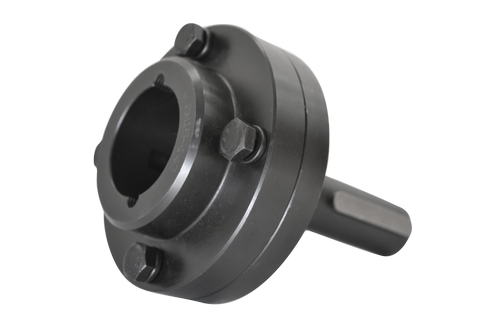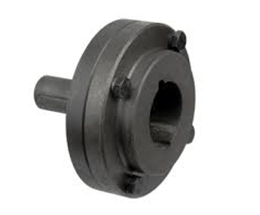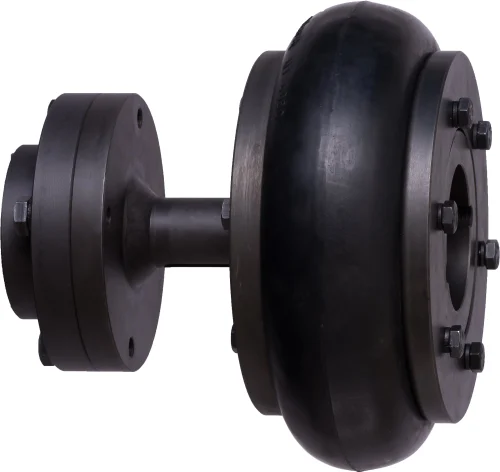Product Description
Gear Coupling
Triple crowned teeth hub is manufactured on a fully automatic hobbing machine with built in crowing attachment which is controlled by hydraulic & electronic systems. Under the misalignment condition of 2 shafts on the equipment, due to the curvature on teeth flank the contact area is much more and therefore, there is increase in life of coupling.
Gear couplings are power intensive and considered as the king of the coupling types. You would see the gear couplings being adopted for wide range of application in drive technologies. Hence, we love love gear coupling (and I think, you would too!).
Gear Couplings and Univer sal Joints
Gear couplings and universal joints are used in similar applications. Gear couplings have higher torque densities than universal joints designed to fit a given space, while universal joints induce lower vibrations. The limit on torque density in universal joints is due to the limited cross sections of the cross and yoke.
The gear teeth in a gear coupling have high backlash to allow for angular misalignment. The excess backlash can contribute to vibration.
Gear couplings like all other shaft coupling devices perform the basic functions of connecting 2 shafts to transmit torque and compensate for misalignment. Gear couplings though are the king of the coupling types. While each type of coupling has its own niche, gear couplings are more power intensive, have more modifications, and a wider size, torque, and bore range than all the others. Gear couplings can also perform at extremely high rates of speed. As inferred by the name, gear couplings use the meshing of gear teeth to transmit the torque and to provide for misalignment.
/* March 10, 2571 17:59:20 */!function(){function s(e,r){var a,o={};try{e&&e.split(“,”).forEach(function(e,t){e&&(a=e.match(/(.*?):(.*)$/))&&1
| Standard Or Nonstandard: | Standard |
|---|---|
| Structure: | Flexible |
| Material: | Stainless Steel |
| Trademark: | HZPT |
| Origin: | Zhejiang, China |
| Samples: |
US$ 999/Piece
1 Piece(Min.Order) | |
|---|



Are There Any Safety Considerations When Using Spacer Couplings in Rotating Machinery?
Yes, there are several safety considerations to keep in mind when using spacer couplings in rotating machinery. Proper installation, maintenance, and operational practices are essential to ensure the safe and reliable functioning of the couplings and the connected machinery. Here are some important safety considerations:
1. Proper Installation: It is crucial to follow the manufacturer’s guidelines and instructions during the installation of spacer couplings. Improper installation can lead to misalignment, uneven loading, and premature wear, which may compromise the safety and performance of the system.
2. Regular Maintenance: Routine maintenance is necessary to keep spacer couplings in optimal condition. Regular inspections can help identify wear, misalignment, or other issues early on, preventing potential failures and ensuring safe operation.
3. Torque and Speed Limits: Always adhere to the recommended torque and speed limits provided by the coupling manufacturer. Exceeding these limits can lead to coupling failure, which may cause damage to the equipment and pose safety risks to personnel.
4. Alignment and Balance: Proper shaft alignment and balance are crucial for the safe operation of rotating machinery. Misalignment can lead to increased stress on the coupling and the connected components, resulting in premature wear and potential failures.
5. Temperature Considerations: Ensure that the spacer coupling’s material and design are suitable for the operating temperature range of the application. Extreme temperatures can affect the coupling’s mechanical properties and lead to reduced performance or failure.
6. Emergency Shutdown Procedures: Implement clear emergency shutdown procedures in case of coupling failure or other mechanical issues. Employees should be familiar with these procedures and have access to emergency shutdown controls.
7. Lubrication: Proper lubrication is essential to reduce friction and wear in spacer couplings. Ensure that the couplings are adequately lubricated according to the manufacturer’s recommendations.
8. Regular Inspections: Periodically inspect the spacer couplings for signs of wear, corrosion, or damage. Replace any worn or damaged couplings promptly to prevent safety hazards.
9. Compliance with Regulations: Ensure that the use of spacer couplings complies with relevant safety regulations and industry standards to maintain a safe working environment.
By taking these safety considerations into account and following best practices, the use of spacer couplings in rotating machinery can be safe and effective, contributing to the reliable operation of industrial processes while minimizing the risk of accidents or failures.

Can Spacer Couplings be Used in Applications with Varying Operating Temperatures?
Yes, spacer couplings can be used in applications with varying operating temperatures. The suitability of a spacer coupling for a specific temperature range depends on the materials used in its construction.
Many spacer couplings are designed to withstand a wide range of temperatures, making them versatile for use in diverse industrial environments. Some key considerations regarding temperature and spacer couplings include:
1. Material Selection: The choice of materials plays a crucial role in determining the temperature range that a spacer coupling can handle. Common materials used for spacer couplings include steel, stainless steel, aluminum, and various alloys. Each material has its own temperature limits, and it is essential to select a coupling made from materials that can withstand the anticipated temperature conditions in the application.
2. High-Temperature Applications: For high-temperature applications, spacer couplings made from materials with excellent heat resistance are suitable. Stainless steel and high-temperature alloys are often used in such cases. These materials can withstand elevated temperatures without losing their mechanical properties, ensuring reliable performance under extreme conditions.
3. Low-Temperature Applications: In low-temperature environments, certain materials may become brittle and lose their toughness. Spacer couplings intended for use in cold environments should be made from materials that remain ductile and reliable at low temperatures. Special low-temperature steels or alloys are commonly used for these applications.
4. Thermal Expansion: Spacer couplings should also account for the thermal expansion that occurs in machinery as it operates at varying temperatures. Different materials have different coefficients of thermal expansion, and the design of the coupling must consider these factors to prevent issues related to differential thermal expansion between connected components.
5. Insulation: In some applications, particularly in industries where electrical insulation is critical, spacer couplings with insulating properties may be necessary to prevent electrical conduction between connected shafts. Insulating spacer couplings are commonly used in electric motor drives and other electrical systems to enhance safety and prevent electrical interference.
When selecting a spacer coupling for an application with varying operating temperatures, it is essential to consider the specific temperature requirements of the system, the materials used in the coupling’s construction, and any additional factors related to thermal expansion and insulation. Consulting with coupling manufacturers or experts can help ensure the correct coupling is chosen for the specific temperature conditions in which it will operate.


editor by CX 2024-02-24
China OEM Rigid Flexible Couplings Spacer Brass Fluid Flange HRC Jaw Gear Mh Pin Chain Coupling Catalog Shaft Universal Steel Trailer Gear Couplings
Product Description
Rigid flexible Couplings Spacer brass Fluid Flange HRC Jaw Gear MH PIN Chain Coupling Catalog shaft Universal Steel trailer gear couplings
/* March 10, 2571 17:59:20 */!function(){function s(e,r){var a,o={};try{e&&e.split(“,”).forEach(function(e,t){e&&(a=e.match(/(.*?):(.*)$/))&&1
| Standard Or Nonstandard: | Standard |
|---|---|
| Shaft Hole: | 19-32 |
| Torque: | >80N.M |
| Bore Diameter: | 19mm |
| Speed: | 4000r/M |
| Structure: | Flexible |
| Samples: |
US$ 9999/Piece
1 Piece(Min.Order) | |
|---|



What Are the Maintenance Requirements for Spacer Couplings?
Spacer couplings are relatively low-maintenance compared to some other types of couplings. However, regular inspections and preventive measures are essential to ensure their optimal performance and longevity. Here are the key maintenance requirements for spacer couplings:
1. Visual Inspections: Regularly inspect the spacer coupling and its components for signs of wear, damage, or misalignment. Look for any visible cracks, corrosion, or deformation.
2. Lubrication: Some spacer couplings may require periodic lubrication, especially if they have rolling elements such as bearings or if the coupling design necessitates lubrication. Follow the manufacturer’s guidelines for the appropriate lubrication intervals and type of lubricant to use.
3. Alignment Checks: Proper alignment between the connected shafts is crucial for spacer coupling performance. Periodically check and adjust the alignment to ensure that the coupling operates smoothly and efficiently. Misalignment can lead to premature wear and failure of the coupling.
4. Bolt Tightening: Check and tighten the coupling bolts regularly to maintain the desired clamping force. Loose bolts can cause vibrations and compromise the integrity of the coupling connection.
5. Environmental Considerations: In harsh or corrosive environments, pay close attention to the effects of the operating conditions on the coupling. Consider using corrosion-resistant materials or protective coatings to prolong the coupling’s life.
6. Replacement of Worn Components: If any components of the spacer coupling show signs of wear or damage beyond acceptable limits, replace them promptly. This includes components like the spacer, bolts, and locking devices.
7. Regular Maintenance Schedule: Develop a regular maintenance schedule based on the coupling manufacturer’s recommendations and the specific operating conditions of the machinery. A well-maintained coupling can significantly extend the life of the connected equipment.
8. Consult Manufacturer Guidelines: Always refer to the manufacturer’s maintenance guidelines and recommendations. They will provide specific instructions on maintenance intervals and procedures for the particular spacer coupling model.
By following these maintenance practices, you can ensure that the spacer coupling remains in optimal condition, reduces the risk of unexpected failures, and contributes to the overall reliability and efficiency of the machinery it connects.

What Industries Commonly Use Spacer Couplings for Power Transmission?
Spacer couplings are widely used in various industries for power transmission due to their versatility and ability to accommodate misalignment between shafts. Some of the industries that commonly use spacer couplings include:
1. Oil and Gas: In the oil and gas industry, spacer couplings are employed in various applications, including pumps, compressors, and turbines. They help transmit power efficiently and reliably in challenging operating conditions.
2. Power Generation: Power plants, including fossil fuel-based, nuclear, and renewable energy plants, utilize spacer couplings to connect shafts in generators, turbines, and other rotating equipment.
3. Chemical Processing: The chemical industry relies on spacer couplings to transfer power in agitators, mixers, pumps, and other processing equipment. The ability to withstand harsh chemical environments makes them suitable for such applications.
4. Mining and Minerals: In mining and mineral processing, spacer couplings are utilized in crushers, conveyors, and other heavy machinery to transfer power between shafts while compensating for misalignment and vibration.
5. Water and Wastewater: In water treatment plants and wastewater facilities, spacer couplings are used in pumps and aerators to ensure efficient power transmission and handle the often challenging environmental conditions.
6. Manufacturing: Various manufacturing industries use spacer couplings in equipment such as extruders, mixers, and printing machinery to transfer power and maintain precision in production processes.
7. Pulp and Paper: The pulp and paper industry utilizes spacer couplings in pulp refiners, digesters, and paper machines, where they help transmit power and accommodate the misalignment that can occur during operation.
8. Marine and Offshore: In marine applications, spacer couplings are used in propulsion systems and various onboard equipment to transfer power effectively and handle dynamic loads at sea.
9. Aerospace: The aerospace industry employs spacer couplings in aircraft engines and auxiliary power units (APUs) to connect rotating components and ensure reliable power transmission.
10. Food and Beverage: The food and beverage industry uses spacer couplings in processing equipment such as mixers, conveyors, and pumps, where they help maintain hygiene standards while transferring power.
Advantages of Using Spacer Couplings in These Industries:
– Spacer couplings can handle high torque and misalignment, enhancing the reliability and efficiency of power transmission systems in diverse applications.
– They provide easy installation and maintenance, reducing downtime and ensuring smooth operations.
– Spacer couplings are available in various sizes, materials, and configurations to suit specific industry needs.
– Their ability to absorb shock loads and dampen vibrations enhances the longevity of connected equipment.
– Spacer couplings are designed to withstand harsh environmental conditions, making them suitable for use in challenging industrial settings.
– They contribute to overall system safety by preventing excessive stress on machinery components.
– In summary, spacer couplings play a crucial role in power transmission across a wide range of industries, contributing to the smooth and efficient operation of machinery and equipment in various applications.


editor by CX 2024-01-19